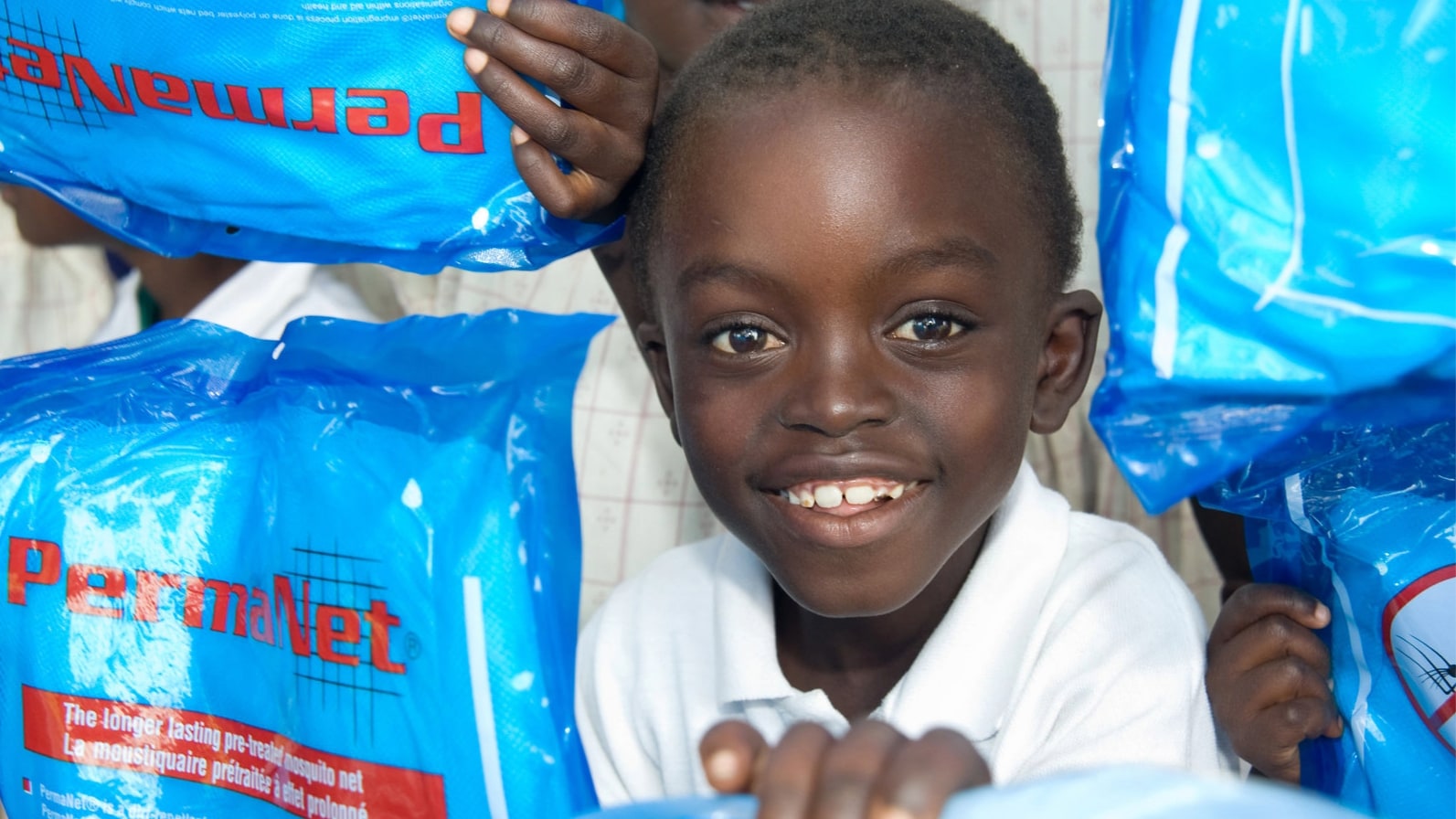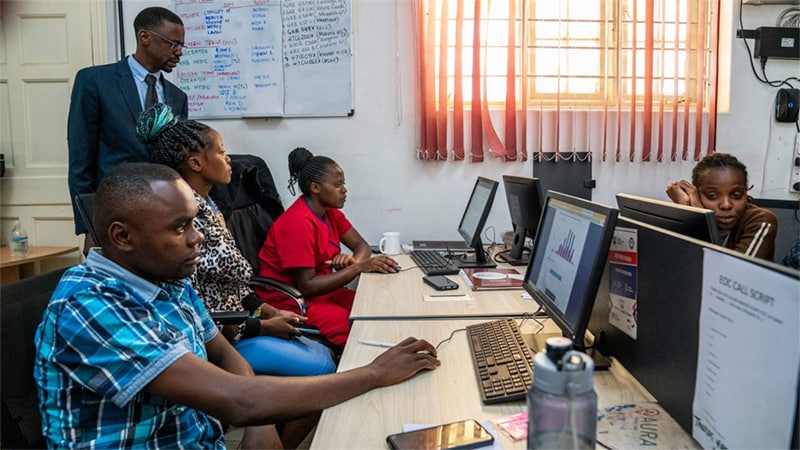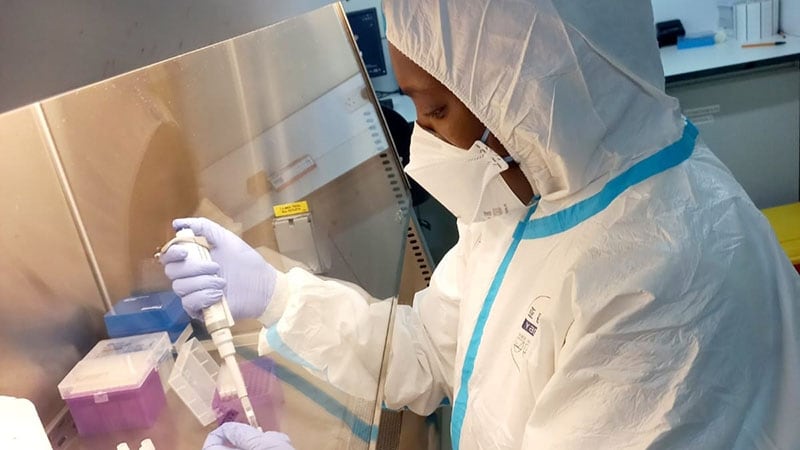At a glance
For 45 years, CDC has helped strengthen Kenya’s public health and laboratory systems and operate an integrated research center. CDC Kenya implements the U.S. President’s Emergency Plan for AIDS Relief, U.S. President’s Malaria Initiative, and Global Health Security Agenda. CDC also supports surveillance, workforce development, and public health emergency preparedness.

Overview

CDC established an office in Kenya in 1979. CDC Kenya works closely with the Kenya Ministry of Health (MOH) and partner organizations to address the following public health topics:
- Health systems strengthening
- HIV
- Tuberculosis
- Malaria
- Migration health
- Immunization
- Influenza
Global health security
Strategic focus
In partnership with the Government of Kenya, CDC helps prevent disease and death by implementing evidence-based public health programs.
Surveillance systems
CDC conducts surveillance to better understand emerging health threats and how to prevent them. This strengthens Kenya's ability to rapidly detect and respond to disease outbreaks and other health threats. CDC enhances surveillance and health information systems by:
- Supporting the development and implementation of population, facility-based, rapid mortality, and event-based surveillance systems.
- Spearheading state-of-the-art and mobile data collection systems.
- Implementing the Child Health and Mortality Prevention Surveillance program.
- Supporting the Health and Demographic Surveillance System.
Surveillance platforms funded and guided by CDC for acute febrile illness, respiratory diseases, diarrheal disease, malaria, antimicrobial resistance, and other public health events provide real-time disease intelligence to Kenya Ministry of Health (MOH). These surveillance systems have generated evidence that supports implementation of preventive measures like rotavirus vaccination in children.
Laboratory systems strengthening

CDC strengthens laboratory systems in Kenya by helping to build the critical laboratory network necessary to assure health security.
Two CDC-supported laboratories housed at the Kenya Medical Research Institute (KEMRI) provide advanced diagnostic testing for diseases of public health concern, like molecular detection of viral hemorrhagic fevers and genetic sequencing of cholera.
CDC provides support to the Kenya National Public Health Laboratory (NPHL) in Nairobi on diagnostics, outbreak detection and systems development. Several laboratory programs such as HIV and TB drug resistance testing, and the National Influenza Center operate through CDC support. On-going technical assistance priorities include whole genome sequencing and diagnostics capacity for endemic and emerging pathogens.
CDC also provides ongoing support to select regional and county laboratories.
Workforce development
The CDC-supported Field Epidemiology and Laboratory Training Program (FETLP) is designed to build national, regional, and local capabilities to stop diseases at the source. Kenya’s FELTP implements all three programs—Advanced, Intermediate and Frontline. Kenya FELTP graduates are the boots-on-the-ground for the Ministry of Health, responding to over 80% of outbreaks detected in the country. FETLP graduates can be found in key positions at county and national levels in Kenya.
Emergency response

CDC supported the design and provided equipment for the Kenya National Public Health Emergency Operations Center (PHEOC) established in 2013. CDC has trained Ministry of Health staff in public health emergency management, incident command systems, geographic information systems, risk communication, and through the Public Health Emergency Management Fellowship.
During the COVID-19 response, CDC supported Kenya in data collection, surveillance, laboratory, testing, border health, workforce training, and vaccine rollout efforts.
Clade I mpox in Central and Eastern Africa
Key achievements
- CDC Kenya supports 22 PHEOCs that are strategically located in counties that contain over half of the population in the country.
- CDC-supported KEMRI and NPHL laboratories can test at least 92 different pathogens and act as frontline testing and training sites.
- CDC provides epidemiological and laboratory support to about 25 outbreak investigations across the country per year.
- CDC-supported KEMRI laboratories test and confirm approximately 52% of disease outbreaks per year.
- CDC-supported KEMRI laboratories test and confirm approximately 52% of disease outbreaks per year.
- For the past 20 years, Kenya's FELTP has trained over 1,500 public health workers who help to detect, prevent, and respond to health threats in the country and the region.
- During the COVID-19 pandemic, CDC Kenya helped start FELTP Frontline programs in Somalia and Djibouti to strengthen the region's workforce.
- During the COVID-19 pandemic, CDC Kenya helped start FELTP Frontline programs in Somalia and Djibouti to strengthen the region's workforce.
HIV and TB
Strategic focus
Since 2004, CDC has supported the Government of Kenya and local and international partners in efforts to strengthen prevention and control of HIV and TB. CDC provides technical and financial support through the U.S. President's Emergency Plan for AIDS Relief (PEPFAR). CDC works to:
- Develop strategic policy guidelines, national HIV surveillance, and strategic information systems, enabling early adoption of new scientific evidence and data use.
- Improve service delivery in HIV and TB prevention, identification, linkage, treatment, and retention of people living with HIV or TB.
- Implement high-quality laboratory services, strengthening health systems, and establishing close partnerships with national and county governments to enhance program sustainability.
- Establish and maintain sound financial management systems to ensure transparency, accountability, and compliance with required regulations.
Key achievements
- More than 1.3 million people living with HIV are on antiretroviral treatment. More than 790,000 people receive treatment in CDC-supported health facilities.
- Over 360,000 pregnant women know their HIV status due to testing by CDC-supported sites, and 99% are on HIV treatment. Of those, 95% have an undetectable HIV viral load.
- 96% of HIV/TB patients treated in CDC-supported sites received ART while on TB treatment.
- Over the last 15 years, 89 labs received international accreditation—contributing to 1.2 million HIV viral load tests, 900,000 TB tests, and 11 million HIV diagnostic tests per year.
- 92% of patients on treatment have an electronic medical record for more efficient tracking.
Immunization
Strategic focus
CDC's Global Immunization Program supports the Government of Kenya and the region in developing national policies, strategies, and action plans. The program also implements and monitors projects to prevent and control vaccine-preventable diseases. CDC Kenya assisted the Government of Kenya in preparing for and accelerating COVID-19 vaccination.
CDC's activities focus on maintaining polio-free status, achieving measles elimination and rubella control, and maintaining elimination of maternal and neonatal tetanus.
CDC’s Immunization Program also enhances Kenya's vaccine preventable diseases laboratory systems by supporting diagnostics, outbreak detection, and sequencing for polio, measles, and rubella. Ongoing work includes technical assistance to expand polio sequencing capacity in KEMRI laboratories in Kenya.
Key achievements
- CDC provided close to $4 million to support the Kenya Ministry of Health’s COVID-19 vaccination rollout.
- CDC supported a measles-rubella vaccination campaign in high-risk counties in Kenya resulting in the vaccination of over 3 million children.
- CDC is supporting Kenya’s polio outbreak response, which has vaccinated nearly 9 million children under 15 years with novel type 2 oral poliovirus vaccine.
Malaria
Strategic focus
Kenya's entire population is at risk for malaria. As a co-implementer of the U.S. President’s Malaria Initiative (PMI), CDC coordinates with USAID, the Government of Kenya, and partners to implement and evaluate malaria prevention and control activities. CDC has also collaborated with KEMRI since 1979 to establish one of the premier malaria research field stations in the world.
Key achievements
Since 2008, CDC's support through PMI has helped:
- Deliver over 28 million mosquito nets and insecticide to spray over 6 million homes.
- Protect nearly 4 million pregnant women with preventive treatment.
- Provide nearly 45 million rapid diagnostic tests.
- Deliver over 76 million fast acting malaria medicines.
Influenza
Strategic focus
CDC’s Influenza Program Regional Hub in Kenya supports enhanced surveillance and laboratory capacity. This allows for the timely detection and characterization of seasonal influenza, detection of novel viruses, as well as other respiratory viruses of pandemic potential. CDC works closely with partners and Ministries of Health in Kenya and other countries in the region including Ethiopia, South Sudan, Tanzania, and Uganda.
Key achievements
- CDC supported the Ministries of Health in Kenya to develop its pandemic influenza preparedness plan following the A(H1N1) pandemic in 2009 and supported an update of the vaccine deployment plan in 2017.
- CDC supported the establishment of Kenya’s National Influenza Center (NIC) in 2014. In 2018, WHO AFRO certified the Kenya NIC.
- Since 2015, CDC has conducted a prospective, multi-year influenza mother/baby cohort to estimate incidence of influenza in Kenya.
- CDC supports the NIC to conduct surveillance for COVID-19 and other respiratory pathogens and to respond to respiratory disease outbreaks.
- Since 2021, CDC supports the Kenya Central Veterinary Laboratory to conduct routine avian influenza surveillance and identify viruses with pandemic potential.
Migration health
Strategic focus
It is anticipated that approximately 20,000 refugees per year will resettle into the United States from Africa – the largest contributor to the U.S. refugee resettlement program.
CDC's Global Migration Health Africa Program, located in Kenya, works with local and international partners to address public health needs associated with population mobility. The program is responsible for the medical requirements for U.S. immigration and refugee resettlement to prevent importation of infectious diseases of public health significance into the United States.
The program collaborates with the following partners:
- U.S. Department of State Bureau for Population, Refugees, and Migration
- U.S. consulates
- International Organization for Migration
- United Nations Refugee Agency
- Foreign ministries of health
- Non-governmental organizations providing healthcare and preventive services to refugee populations.
Key achievements
- CDC supports respiratory disease surveillance and laboratory capacity development in Kenya's two refugee camps—home to over 400,000 refugees. This activity strengthens detection of outbreak-prone diseases.
- CDC strengthened vaccine delivery systems in Kenya's refugee camps to improve access to COVID-19 vaccines and other vaccination programs.
- CDC provides technical assistance to partners to improve surveillance, preparedness, and response at border crossings, ports of entry, and between countries.
Applied Science Hub
The Applied Science Hub is implemented in collaboration with host nation research institutions. This is CDC’s flagship international research site. It has developed into a comprehensive platform for enhanced surveillance activities, scientific study, and service delivery particularly in the fields of HIV, TB, malaria, and maternal and child health. This platform attracts research projects and significant funding from academic institutions, the National Institutes of Health, and non-governmental organizations such as the Bill & Melinda Gates Foundation.
Success story spotlight
Kenya: Fast detection, faster response to stop mpox

In July 2024, Kenya reported its first-ever clade Ib mpox case. The Kenya Ministry of Health (MOH) detected and responded to the case quickly, thanks to core public health capabilities built and enhanced in partnership with CDC.
Core public health capabilities prove their value
Kenya's response began as soon as a port health officer identified a traveler at the Kenya-Tanzania border who presented with the characteristic mpox rash. They had the ability to quickly report the suspected mpox case to the MOH because of a digital system built with CDC support. The system monitors for diseases of public health significance among international air travelers and truck drivers crossing into Kenya.
After the traveler was isolated, samples were collected and sent to multiple laboratories to confirm if the rash was due to mpox, including to the CDC-supported lab in Nairobi. When the test came back positive for monkeypox virus, results were shared with the Ministry of Health that same day. This swift action set even more wheels in motion.
Disease detectives trained by Kenya's CDC-supported Field Epidemiology and Laboratory Training Program (FELTP) launched into action. "We quickly deployed to investigate the confirmed mpox case, identify exposed persons, and monitor contacts for any symptoms that could indicate transmission," said Kenya FELTP resident Dr. Pius Mutuku.
Kenya also activated its CDC-supported Emergency Operations Centers (EOCs) to manage the response. In addition to the country's national EOC, CDC partnered with Kenya to create a network of more than 20 sub-national EOCs that can help control outbreaks closer to the source. As of 2024, these EOCs have responded to more than 100 disease outbreaks.
The right information at the right time saves lives
Critically, the country immediately launched a mass messaging campaign to educate the public about preventive measures and reduce stigma associated with mpox. As in many other places, mpox misinformation and disinformation is rapidly spreading in Kenya through social media and other platforms. To help combat this, Kenya partners and CDC staff worked together to:
- Hold a press briefing with media outlets to help inform the public
- Develop informational resources to help healthcare workers recognize the signs and symptoms of mpox, and take the appropriate infection prevention and control measures to keep themselves and their patients safe
- Share credible, reliable, and actionable messages with people and communities through social media, newspapers, radio, and television.
The messaging campaign had an immediate effect. After hearing about the risks, a second person recognized their own symptoms and sought medical attention at a port of entry along the Kenya-Uganda border. Quick action is critical to finding and stopping further spread of mpox.
While the mpox situation is still evolving, CDC will continue supporting Kenya as they tackle a disease threat they have never faced before.
"CDC Kenya is supporting the government of Kenya to ensure screening of all travelers at points of entry to prevent importation of diseases and supporting mpox response efforts to help keep people safe," said Dr. Maurice Ope of CDC's Kenya office. "A disease threat anywhere is a disease threat everywhere."
